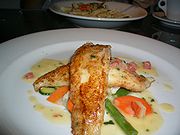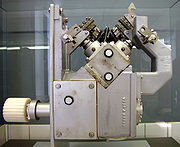
Fillet (cut)
Encyclopedia

Meat
Meat is animal flesh that is used as food. Most often, this means the skeletal muscle and associated fat and other tissues, but it may also describe other edible tissues such as organs and offal...
or fish
Fish
Fish are a paraphyletic group of organisms that consist of all gill-bearing aquatic vertebrate animals that lack limbs with digits. Included in this definition are the living hagfish, lampreys, and cartilaginous and bony fish, as well as various extinct related groups...
.
Meat
In the case of beef, in the USA, the term most often refers to beef tenderloinBeef tenderloin
A beef tenderloin, known as an eye fillet in New Zealand and Australia, filet in France and Germany and fillet in the United Kingdom, is cut from the loin of beef. As with all quadrupeds, the tenderloin refers to the psoas major muscle ventral to the transverse processes of the lumbar vertebrae,...
, especially filet mignon
Filet mignon
Filet mignon is a steak cut of beef taken from the smaller end of the tenderloin, or psoas major of the beef carcass, usually a steer or heifer...
.
Chicken
ChickenChicken
The chicken is a domesticated fowl, a subspecies of the Red Junglefowl. As one of the most common and widespread domestic animals, and with a population of more than 24 billion in 2003, there are more chickens in the world than any other species of bird...
fillets are cut from chicken breasts or chicken thighs. Boneless, skinless chicken fillets are very popular in supermarkets
Supermarket
A supermarket, a form of grocery store, is a self-service store offering a wide variety of food and household merchandise, organized into departments...
in many countries.
Fish

Steak
A steak is a cut of meat . Most are cut perpendicular to the muscle fibers, improving the perceived tenderness of the meat. In North America, steaks are typically served grilled, pan-fried, or broiled. The more tender cuts from the loin and rib are cooked quickly, using dry heat, and served whole...
s. The remaining bones with the attached flesh is called the "frame", and is often used to make fish stock
Stock (food)
Stock is a flavoured water preparation. It forms the basis of many dishes, particularly soups and sauces.- Preparation :Stock is made by simmering various ingredients in water, including some or all of the following...
. As opposed to whole fish or fish steaks, fillets do not contain the fish's backbone; they yield less flesh, but are easier to eat.
Special cut fillets are taken from solid large blocks; these include a "natural" cut fillet, wedge, rhombus or tail shape. Fillets may be skinless or have skin on; pinbones may or may not be removed.
A fletch is a large boneless fillet of halibut
Halibut
Halibut is a flatfish, genus Hippoglossus, from the family of the right-eye flounders . Other flatfish are also called halibut. The name is derived from haly and butt , for its popularity on Catholic holy days...
, swordfish
Swordfish
Swordfish , also known as broadbill in some countries, are large, highly migratory, predatory fish characterized by a long, flat bill. They are a popular sport fish of the billfish category, though elusive. Swordfish are elongated, round-bodied, and lose all teeth and scales by adulthood...
or tuna
Tuna
Tuna is a salt water fish from the family Scombridae, mostly in the genus Thunnus. Tuna are fast swimmers, and some species are capable of speeds of . Unlike most fish, which have white flesh, the muscle tissue of tuna ranges from pink to dark red. The red coloration derives from myoglobin, an...
.
There are several ways to cut a fish fillet:
- Cutlet
- This fillet is obtained by slicing from behind the head of the fish, round the belly and tapering towards the tail. The fish is then turned and the process repeated on the other side to produce a double fillet
- Single
- This fillet is more complex than the cutlet and produces 2 separate fillets, one from each side of the fish.
- "J" Cut
- This fillet is produced in the same way as a single fillet but the pin bones are removed by cutting a "J" shape from the fillet
- "Back strap"
- After filleting both sides of the fish you will have almost all the meat, but there is a little known cut called the back strap. To get to the back strap you must cut on the gill line and run the knife right above the back bone. Run the knife all the way done the back bone and finish at the base of the tail.

